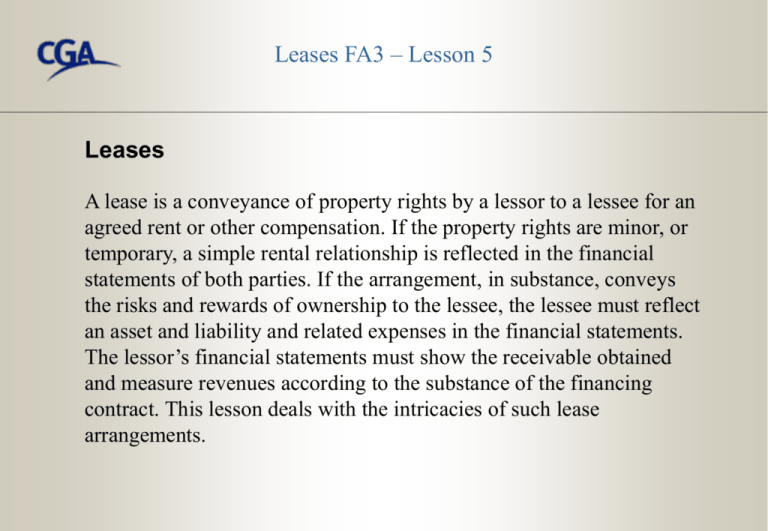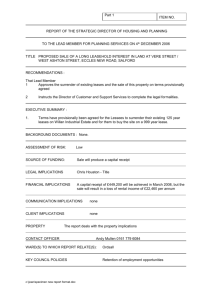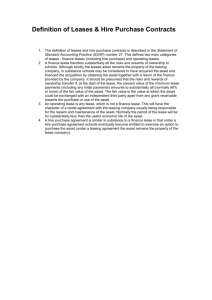Leases
advertisement

Leases FA3 – Lesson 5 Leases A lease is a conveyance of property rights by a lessor to a lessee for an agreed rent or other compensation. If the property rights are minor, or temporary, a simple rental relationship is reflected in the financial statements of both parties. If the arrangement, in substance, conveys the risks and rewards of ownership to the lessee, the lessee must reflect an asset and liability and related expenses in the financial statements. The lessor’s financial statements must show the receivable obtained and measure revenues according to the substance of the financing contract. This lesson deals with the intricacies of such lease arrangements. Leases FA3 – Lesson 5 Memory Hook Lessor e v e n u e Lessor Receives Revenue Lessee x p e n s e Lessee has Expense Leases FA3 – Lesson 5 Conditional Sales Agreement (CSA) A Company acquires a capital asset The acquisition is financed by the Vendor or Finance Company with a CSA The Vendor or Finance Company retains title to the capital asset Title passes to the Company when the last payment is made The Company accounts for the CSA as purchase of Capital Assets and a Long-Term Liability Leases FA3 – Lesson 5 What happens with a capital lease? Lease agreements may represent, in substance, the purchase/sale of an asset, and a corresponding obligation/lease receivable. This happens when the risks and rewards of ownership pass to the lessee. If this is the case, the lessor takes the asset off its books, and replaces it with a loan receivable. The lessee records both an asset and a liability. Leases FA3 – Lesson 5 What is an operating lease? Leases that are not capital leases are classified as operating leases. For operating leases: The contract is a simple rental agreement. The lease does not give rise to property rights. Payments are expensed as time passes or benefits are received. Leases FA3 – Lesson 5 New Terms MLPs BPO UngR GR IBR IIR ITC CCA Minimum Lease Payments Bargain Purchase Option Unguaranteed Residual Guaranteed Residual Incremental Borrowing Rate (lessee’s rate) Implicit Interest Rate (lessor’s rate) Investment Tax Credit Capital Cost Allowance Leases FA3 – Lesson 5 When is a lease a capital lease for the lessee? A lease is a capital lease if it meets one of the following conditions: Title passes to lessee by end of lease. There is a bargain purchase option. (BPO) The lease covers 75% or more of the life of the asset. The present value of the lease payments is 90% or more of the fair value of the asset at inception of the lease. Leases FA3 – Lesson 5 When is a lease a capital lease for the lessor? One of the four previous criteria has been met, plus: There must be an acceptable credit risk associated with the lease payments and no unreimbursable or unestimatable costs. It is a direct financing lease if lessor is a financing company. It is a sales type lease if lessor is a manufacturer/trader. Leases FA3 – Lesson 5 What happens on the lessee's books? A leased asset and a lease liability are recognized at the PV of lease payments. (PV of MLPs using lower of IIR and IBR) A leased asset is used by the lessee over the lease term and is amortized like any other owned asset. A lease obligation, like any other interestbearing obligation, is increased by interest each period and reduced by payments made. Leases FA3 – Lesson 5 What are some of the advantages and disadvantages of leases? Leasing is an attractive form of financing, providing: flexible access to assets, protection from interest rate changes, 100% financing, off-balance sheet financing for operating leases, & some possible tax advantages. A lease may be more expensive than traditional lending arrangements and may lock the lessee into a long-term obligation. Leases FA3 – Lesson 5 What happens on the lessor’s books? The lessor records: the lease payments receivable from the lessee, a contra account for unearned interest revenue, & removes the leased asset from its books. In a sales-type lease, cost of sales and sales revenue are also recorded. (same as a normal sale) Cash received reduces the receivable, and interest earned on the net balance is recognized as time passes. Leases FA3 – Lesson 5 What is unique about real estate leases? Land might be one of the leased assets. A land lease is only classified as a capital lease if title passes or if there is a bargain purchase option. Otherwise, it is an operating lease. If a lease covers more than one asset, the lease payments must be allocated to each asset based on relative fair values. Leases FA3 – Lesson 5 How do the tax and accounting treatments of leases differ? Tax and accounting treatments of leases are often different, causing “future income taxes” to be recorded. A lease is a capital lease for tax purposes only if title passes. A lessee with a capital lease for tax purposes would be eligible for CCA and ITCs. Leases FA3 – Lesson 5 How does Canada’s treatment of leases compare to international standards? There is a lot of diversity around the world regarding lease accounting. While some countries follow capitalization rules, it is also common for all leases to be treated as rental contracts. Leases FA3 – Lesson 5 How are leases disclosed on financial statements? Financial statement disclosure for the lessee includes segregating assets under capital lease from other assets and disclosing accumulated amortization. Liability is shown for both short- and long-term portions. Amortization and interest expense are disclosed. continued... Leases FA3 – Lesson 5 How are leases disclosed on financial statements? (continued) Notes include amortization policy, terms of the liability, and a five-year cash flow schedule. For the lessor, the balance sheet reflects net receivables and the income statement, finance revenue. Disclosure of terms and conditions and five-year cash flow is required. Leases FA3 – Lesson 5 How are leases recognized on the cash flow statement? Initial recognition of a leased asset is a non-cash transaction. Payment of the liability is a financing outflow. Amortization is added back in operations if indirect method is used.


